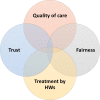The role of cultural safety and ethical space within postcolonial healthcare for Maasai in Tanzania
- PMID: 36356986
- PMCID: PMC9660600
- DOI: 10.1136/bmjgh-2022-009907
The role of cultural safety and ethical space within postcolonial healthcare for Maasai in Tanzania
Abstract
The history of the Maasai tribe in northern Tanzania is characterised by marginalisation, discrimination and political subjugation. Inequities, enacted through power relations, influence healthcare access, practices and outcomes among the Maasai. Cultural safety and ethical space provide lenses into social, political and historical influences on access to care, helping to understand the realities of historically marginalised populations such as the Maasai, and responses to health services. This study aims to examine Maasai experiences of accessing and uptake of health services within a postcolonial discourse in Tanzania. In an ethnographic study examining access and perceptions of healthcare services in Maasai communities, lead authors conducted participant observations and at health facilities to document experiences. Household interviews, a group oral history and interviews with NGOs working with Maasai communities, contributed to the data analysed. Inductive thematic analysis was used to understand healthcare experiences within a framework of cultural safety and ethical space. Despite trust in biomedicine, Maasai people have a strong desire for health services with particular characteristics. Quality of care, including facilities and diagnostics available and used, was important. A sense of fairness was a determinant in respecting services including 'first come first serve' system and transparency when unable to treat a condition. Trust in health services was also influenced by personal interactions with health workers, including provision of health information provided to patients and instances of being mistreated. These findings offer an understanding of ways in which spaces of healthcare can be more approachable and trusted by Maasai. Incorporating cultural safety and ethical spaces to understand healthcare access can help to reduce the power imbalance possibly resulting from a history of marginalisation. This can inform development of culturally appropriate programmes, used to educate healthcare professionals and advocate for improved healthcare services for marginalised groups.
Keywords: Health services research; Public Health; Qualitative study.
© Author(s) (or their employer(s)) 2022. Re-use permitted under CC BY-NC. No commercial re-use. See rights and permissions. Published by BMJ.
Conflict of interest statement
Competing interests: None declared.
Figures
Similar articles
-
Understanding hard-to-reach communities: local perspectives and experiences of trachoma control among the pastoralist Maasai in northern Tanzania.J Biosoc Sci. 2021 Nov;53(6):819-838. doi: 10.1017/S0021932020000553. Epub 2020 Sep 25. J Biosoc Sci. 2021. PMID: 32981544
-
Provision and uptake of routine antenatal services: a qualitative evidence synthesis.Cochrane Database Syst Rev. 2019 Jun 12;6(6):CD012392. doi: 10.1002/14651858.CD012392.pub2. Cochrane Database Syst Rev. 2019. PMID: 31194903 Free PMC article.
-
"We are doctors": Drivers of animal health practices among Maasai pastoralists and implications for antimicrobial use and antimicrobial resistance.Prev Vet Med. 2021 Mar;188:105266. doi: 10.1016/j.prevetmed.2021.105266. Epub 2021 Jan 20. Prev Vet Med. 2021. PMID: 33517159
-
Development and Implementation of a Culturally Appropriate Education Program to Increase Cervical Cancer Screening among Maasai Women in Rural Tanzania.Ann Glob Health. 2019 Oct 17;85(1):127. doi: 10.5334/aogh.2503. Ann Glob Health. 2019. PMID: 31673514 Free PMC article.
-
Opportunities and practices supporting responsive health care for forced migrants: lessons from transnational practice and a mixed-methods systematic review.Health Soc Care Deliv Res. 2025 May;13(13):1-182. doi: 10.3310/MRWK3419. Health Soc Care Deliv Res. 2025. PMID: 40326302
References
-
- Wagner-Glenn D. Searching for a baby’s calabash: a study of Arusha Maasai fertility songs as chrystallized [sic] expression of central cultural values. Philipp Verlag, 1992.
-
- Homewood K. Development, demarcation and ecological outcomes in Maasailand. Africa 1995;65:331–50. 10.2307/1161050 - DOI
-
- Spear T, Waller R. Being Maasai: ethnicity and identity in East Africa. Ohio University Press, 1993.
-
- Benjaminsen TA, Goldman MJ, Minwary MY, et al. . Wildlife management in Tanzania: state control, rent seeking and community resistance. Dev Change 2013;44:1087–109. 10.1111/dech.12055 - DOI
-
- Brockington D. Community conservation, inequality and injustice: myths of power in protected area management. Conservation and society 2004:411–32.
Publication types
MeSH terms
Grants and funding
LinkOut - more resources
Full Text Sources
Medical


